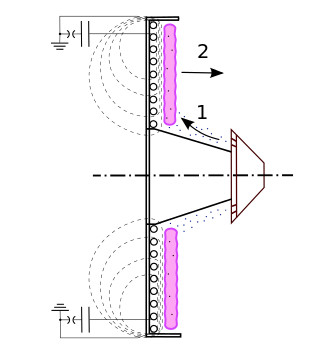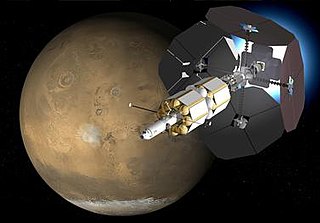
Spacecraft propulsion is any method used to accelerate spacecraft and artificial satellites. In-space propulsion exclusively deals with propulsion systems used in the vacuum of space and should not be confused with space launch or atmospheric entry.

In spacecraft propulsion, a Hall-effect thruster (HET) is a type of ion thruster in which the propellant is accelerated by an electric field. Hall-effect thrusters are sometimes referred to as Hall thrusters or Hall-current thrusters. Hall-effect thrusters use a magnetic field to limit the electrons' axial motion and then use them to ionize propellant, efficiently accelerate the ions to produce thrust, and neutralize the ions in the plume. The Hall-effect thruster is classed as a moderate specific impulse space propulsion technology and has benefited from considerable theoretical and experimental research since the 1960s.

An ion thruster, ion drive, or ion engine is a form of electric propulsion used for spacecraft propulsion. An ion thruster creates a cloud of positive ions from a neutral gas by ionizing it to extract some electrons from its atoms. The ions are then accelerated using electricity to create thrust. Ion thrusters are categorized as either electrostatic or electromagnetic.

A magnetoplasmadynamic (MPD) thruster (MPDT) is a form of electrically powered spacecraft propulsion which uses the Lorentz force to generate thrust. It is sometimes referred to as Lorentz Force Accelerator (LFA) or MPD arcjet.

A pulsed inductive thruster (PIT) is a form of ion thruster, used in spacecraft propulsion. It is a plasma propulsion engine using perpendicular electric and magnetic fields to accelerate a propellant with no electrode.

The Variable Specific Impulse Magnetoplasma Rocket (VASIMR) is an electrothermal thruster under development for possible use in spacecraft propulsion. It uses radio waves to ionize and heat an inert propellant, forming a plasma, then a magnetic field to confine and accelerate the expanding plasma, generating thrust. It is a plasma propulsion engine, one of several types of spacecraft electric propulsion systems.

A magnetohydrodynamic drive or MHD accelerator is a method for propelling vehicles using only electric and magnetic fields with no moving parts, accelerating an electrically conductive propellant with magnetohydrodynamics. The fluid is directed to the rear and as a reaction, the vehicle accelerates forward.
A propellant is a mass that is expelled or expanded in such a way as to create a thrust or another motive force in accordance with Newton's third law of motion, and "propel" a vehicle, projectile, or fluid payload. In vehicles, the engine that expels the propellant is called a reaction engine. Although technically a propellant is the reaction mass used to create thrust, the term "propellant" is often used to describe a substance which contains both the reaction mass and the fuel that holds the energy used to accelerate the reaction mass. For example, the term "propellant" is often used in chemical rocket design to describe a combined fuel/propellant, although the propellants should not be confused with the fuel that is used by an engine to produce the energy that expels the propellant. Even though the byproducts of substances used as fuel are also often used as a reaction mass to create the thrust, such as with a chemical rocket engine, propellant and fuel are two distinct concepts.
Electron cyclotron resonance (ECR) is a phenomenon observed in plasma physics, condensed matter physics, and accelerator physics. It happens when the frequency of incident radiation coincides with the natural frequency of rotation of electrons in magnetic fields. A free electron in a static and uniform magnetic field will move in a circle due to the Lorentz force. The circular motion may be superimposed with a uniform axial motion, resulting in a helix, or with a uniform motion perpendicular to the field resulting in a cycloid. The angular frequency of this cyclotron motion for a given magnetic field strength B is given by

The gridded ion thruster is a common design for ion thrusters, a highly efficient low-thrust spacecraft propulsion method running on electrical power by using high-voltage grid electrodes to accelerate ions with electrostatic forces.

The induction lamp, electrodeless lamp, or electrodeless induction lamp is a gas-discharge lamp in which an electric or magnetic field transfers the power required to generate light from outside the lamp envelope to the gas inside. This is in contrast to a typical gas discharge lamp that uses internal electrodes connected to the power supply by conductors that pass through the lamp envelope. Eliminating the internal electrodes provides two advantages:
MagBeam is the name given to an ion propulsion system for space travel initially proposed by Professor Robert Winglee of the Earth and Space Sciences Department at the University of Washington for the October 2004 meeting of the NIAC. MagBeam is different from a traditional electrostatic ion thruster in several ways, the primary one being that instead of the fuel and propulsion system being part of the payload craft, they are instead located on a platform held in orbit. It has also been suggested that the technology could be used to reduce the amount of space debris in orbit around Earth.

High Power Electric Propulsion (HiPEP) is a variation of ion thruster for use in nuclear electric propulsion applications. It was ground-tested in 2003 by NASA and was intended for use on the Jupiter Icy Moons Orbiter, which was canceled in 2005.
The helicon double-layer thruster is a prototype electric spacecraft propulsion. It was created by Australian scientist Christine Charles, based on a technology invented by Professor Rod Boswell, both of the Australian National University.

A plasma propulsion engine is a type of electric propulsion that generates thrust from a quasi-neutral plasma. This is in contrast with ion thruster engines, which generate thrust through extracting an ion current from the plasma source, which is then accelerated to high velocities using grids/anodes. These exist in many forms. However, in the scientific literature, the term "plasma thruster" sometimes encompasses thrusters usually designated as "ion engines".

Spacecraft electric propulsion is a type of spacecraft propulsion technique that uses electrostatic or electromagnetic fields to accelerate mass to high speed and thus generating thrust to modify the velocity of a spacecraft in orbit. The propulsion system is controlled by power electronics.

Plasma is one of four fundamental states of matter characterized by the presence of a significant portion of charged particles in any combination of ions or electrons. It is the most abundant form of ordinary matter in the universe, mostly in stars, but also dominating the rarefied intracluster medium and intergalactic medium. Plasma can be artificially generated, for example, by heating a neutral gas or subjecting it to a strong electromagnetic field.
A magnetic nozzle is a convergent-divergent magnetic field that guides, expands and accelerates a plasma jet into vacuum for the purpose of space propulsion. The magnetic field in a magnetic nozzle plays a similar role to the convergent-divergent solid walls in a de Laval nozzle, wherein a hot neutral gas is expanded first subsonically and then supersonically to increase thrust. Like a de Laval nozzle, a magnetic nozzle converts the internal energy of the plasma into directed kinetic energy, but the operation is based on the interaction of the applied magnetic field with the electric charges in the plasma, rather than on pressure forces acting on solid walls. The main advantage of a magnetic nozzle over a solid one is that it can operate contactlessly, i.e. avoiding the material contact with the hot plasma, which would lead to system inefficiencies and reduced lifetime of the nozzle. Additional advantages include the capability of modifying the strength and geometry of the applied magnetic field in-flight, allowing the nozzle to adapt to different propulsive requirements and space missions. Magnetic nozzles are the fundamental acceleration stage of several next-generation plasma thrusters currently under development, such as the helicon plasma thruster, the electron-cyclotron resonance plasma thruster, the VASIMR, and the applied-field magnetoplasmadynamic thruster. Magnetic nozzles also find another field of application in advanced plasma manufacturing processes, and their physics are related to those of several magnetic confinement plasma fusion devices.
A thruster is a spacecraft propulsion device used for orbital station-keeping, attitude control, or long-duration, low-thrust acceleration, often as part of a reaction control system. A vernier thruster or gimbaled engine are particular cases used on launch vehicles where a secondary rocket engine or other high thrust device is used to control the attitude of the rocket, while the primary thrust engine is fixed to the rocket and supplies the principal amount of thrust.










